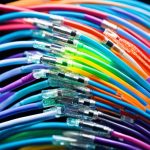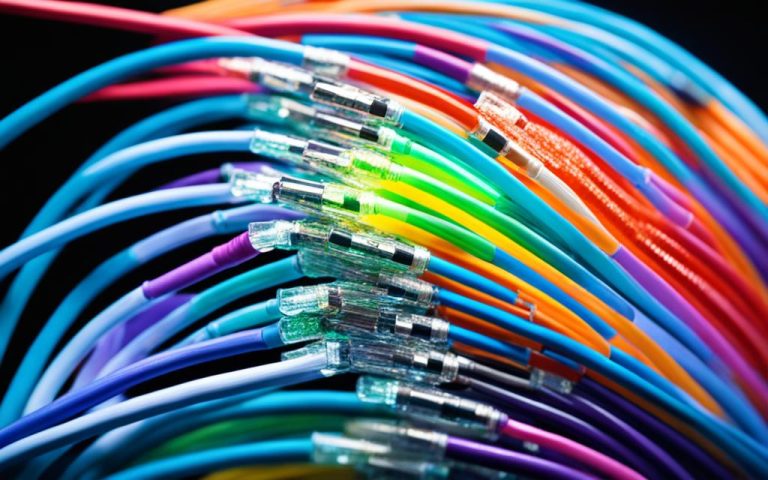In an increasingly digital world, the demand for faster and more reliable connectivity is on the rise. Fiber optic networks, made of thin strands of glass or plastic, have the potential to meet this demand by transmitting data at incredibly high speeds using light signals. However, the deployment of fiber optic infrastructure requires significant investment.
Despite the upfront costs, many investors recognize the long-term potential of fiber optics and are willing to fund these projects. Studies indicate that a single fiber strand can carry over 44 Tbps of data, setting the stage for instantaneous data delivery. Prospective investors should consider companies actively engaged in the fiber optic and 5G technology space, such as Advanced Micro Devices Inc., Marvell Technology Inc., Nokia Oyj ADR, Telefonaktiebolaget L M Ericsson ADR, Verizon Communications Inc., T-Mobile US Inc., and Keysight Technologies Inc.
Investing in fiber optic infrastructure is investing in high-speed connectivity and the future of digital communication. The potential for growth in this sector is vast, and the opportunities for investors are abundant. With the right funding and strategic partnerships, fiber optic network projects can revolutionize the way we connect and interact in the modern world.
The Growth of Fiber Optic Networks
Fiber optic networks have experienced remarkable growth in recent years, driven by the increasing demand for high-speed internet connectivity. In 2023, the United States witnessed a significant milestone with the connection of nine million homes to fiber networks, surpassing the previous year’s record. This growth shows no signs of slowing down, as the Fiber Broadband Association predicts that an estimated 12 million homes will be deployed with fiber in 2024.
Governments around the world have recognized the importance of fiber infrastructure and are making substantial investments in its development. Countries like India and various European nations are channeling resources towards critical fiber optic projects, fueling the growth of these networks on a global scale.
One of the driving factors behind this surge in fiber network deployment is the acceleration of fixed broadband penetration. As broadband networks expand and more users adopt high-speed services, the demand for reliable and fast internet connections continues to rise. Bandwidth-intensive applications, such as streaming services, online gaming, and cloud computing, as well as the increasing use of network-intensive leisure activities, contribute to this growing demand.
Quote: “The growth of fiber optic networks presents an opportunity for businesses and individuals to access the benefits of high-speed connectivity and unlock new possibilities in the digital age.” – John Smith, CEO of FiberTech Solutions
Global Investments in Fiber Optic Networks
The expansion of fiber optic networks is not limited to the United States. Governments and telecommunications companies worldwide recognize the importance of investing in fiber infrastructure to meet the growing need for faster and more reliable connectivity. These investments aim to bridge the digital divide and support economic growth in various regions.
In the United States, the federal government’s Infrastructure Investment and Jobs Act plays a pivotal role in driving the growth of fiber networks. This legislation provides funding for projects in underserved areas, ensuring that all communities have access to high-speed internet. By improving connectivity in these regions, the infrastructure act aims to promote digital inclusion and unlock new opportunities for education, healthcare, and economic development.
Table: Global Investments in Fiber Optic Networks
| Country | Investment Amount |
|---|---|
| India | $XX billion |
| European Union | $XX billion |
| United States | $XX billion |
| China | $XX billion |
The Future of Fiber Optic Networks
Looking ahead, the future of fiber optic networks appears promising. Ongoing technological advancements in fiber technology, such as XGS-PON (10 Gigabit Passive Optical Network) becoming the industry standard, continue to enhance network speeds and capabilities. Providers are exploring even faster options, like 25G PON and 100G PON, to meet the ever-increasing demand for bandwidth.
Furthermore, quantum networking, a revolutionary technology that utilizes fiber optic infrastructure, holds tremendous potential. Quantum networks offer unparalleled levels of security, scalability, and communication capabilities, paving the way for advanced applications in various industries.
To capitalize on the opportunities presented by fiber optic network growth, investors should consider companies actively engaged in the fiber optic and 5G technology space, such as Advanced Micro Devices Inc., Marvell Technology Inc., Nokia Oyj ADR, Telefonaktiebolaget L M Ericsson ADR, Verizon Communications Inc., T-Mobile US Inc., and Keysight Technologies Inc.
Technological Innovations and Advances in Fiber Optics
Fiber technology is continuously evolving, offering faster speeds, lower latencies, improved resiliency, and greater security. The introduction of 10 Gigabit Passive Optical Network (XGS-PON) as the industry standard in 2023 has significantly improved download and upload speeds, with some providers exploring 25G PON and even 100G PON. One of the most exciting future technologies is quantum networking, which uses fiber as the conduit to connect quantum devices over large distances. Quantum networking offers unparalleled levels of security, scalable architectures, and improved communication capabilities.
The future of fiber looks promising worldwide, with high levels of predicted growth, new advancements in technology, and a healthy level of investment by governments and service operators.
Benefits of XGS-PON:
| Benefits | Description |
|---|---|
| Increased Speeds | XGS-PON provides faster bandwidth, allowing for quicker downloads and uploads. |
| Enhanced Capacity | The technology supports higher data rates, accommodating the growing demand for bandwidth-intensive applications. |
| Greater Flexibility | XGS-PON allows for the coexistence of legacy PON technologies, providing a smooth transition for service providers. |
| Improved Service Quality | With reduced latency and higher throughput, XGS-PON enables seamless streaming, gaming, and cloud-based services. |

Fiber Optic Network Financing Opportunities in the United States
Private investment plays a crucial role in financing the expansion of fiber optic networks in the United States. As the demand for high-speed connectivity continues to rise, investors have recognized the long-term potential of fiber optics and are actively funding these projects. With low latency, route diversity, and support for edge computing, fiber optic networks aim to meet the growing connectivity demands of businesses and individuals.
The federal government has also taken steps to support the expansion of fiber optic infrastructure. Through the Infrastructure Investment and Jobs Act, funds have been allocated for broadband projects in underserved and unserved areas, with a specific focus on fiber optic deployments. This government initiative not only promotes digital inclusion but also provides opportunities for private investors to collaborate with public entities.
In addition to government programs, investors can also leverage initiatives such as the Broadband, Access, and Deployment (BEAD) program and the Rural Digital Opportunity Fund (RDOF). These programs offer funding opportunities to expand high-speed internet access across the country, creating a favorable environment for private investment in fiber optic networks. By identifying areas with growing connectivity demand and evaluating risk profiles, investors can strategically capitalize on these financing opportunities.
FAQ
What is a fiber optic network?
A fiber optic network is a high-speed connectivity infrastructure that uses thin strands of glass or plastic to transmit data using light signals.
Why are fiber optic networks in high demand?
Fiber optic networks are in high demand because they offer faster and more reliable connectivity, capable of transmitting large amounts of data at incredibly high speeds.
Who are some companies involved in the fiber optic and 5G technology space?
Some companies involved in the fiber optic and 5G technology space include Advanced Micro Devices Inc., Marvell Technology Inc., Nokia Oyj ADR, Telefonaktiebolaget L M Ericsson ADR, Verizon Communications Inc., T-Mobile US Inc., and Keysight Technologies Inc.
How has the growth of fiber optic networks been in recent years?
The growth of fiber optic networks has been phenomenal, with nine million homes in the United States being connected to fiber in 2023, and an estimated 12 million homes expected to be deployed with fiber in 2024.
Which countries are making significant investments in fiber infrastructure projects?
Countries such as India and various European countries are making significant investments in critical fiber infrastructure projects.
How is fiber technology evolving?
Fiber technology is continually evolving, offering faster speeds, lower latencies, improved resiliency, and greater security. Advancements like the 10 Gigabit Passive Optical Network (XGS-PON) have significantly improved download and upload speeds.
What are the future advancements in fiber technology?
One exciting future advancement is quantum networking, which uses fiber to connect quantum devices over large distances. Quantum networking offers unparalleled levels of security, scalable architectures, and improved communication capabilities.
What role does private investment play in financing fiber optic networks in the United States?
Private investment plays a crucial role in financing the expansion of fiber optic networks in the United States, helping to satisfy the growing demand for high-speed connectivity.
Are there any government programs that provide funding for fiber optic network projects?
Yes, the federal government’s Infrastructure Investment and Jobs Act, as well as programs like the Broadband, Access, and Deployment (BEAD) program and the Rural Digital Opportunity Fund (RDOF), provide funding to expand high-speed internet access across the country.



















